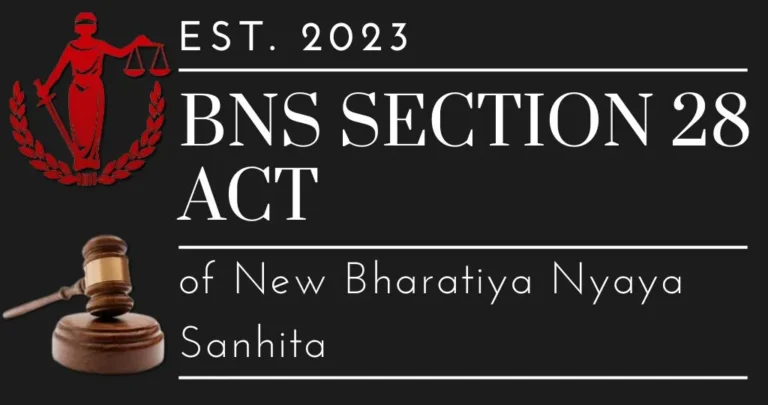
Joinder of Charges Under Section 246: Provisions for Joint Trial of Accused Persons in Bharatiya Nagarik Suraksha Sanhita, 2023
Joinder of Charges under Section 246: Provisions Relating to Joint Trial of Accused Individuals under Bharatiya Nagarik Suraksha Sanhita, 2023
Section 246 in the Bharatiya Nagarik Suraksha Sanhita, 2023 formulates elaborate principles for the trial of more than one person jointly in some situations. These provisions seek to simplify the judicial process by enabling individuals who are involved in connected offences to be tried in one trial, so that there is no need for individual trials in instances where offences are connected by nature or form part of the same transaction. The following explanation addresses each provision, with a brief mention of relevant sections in this chapter to ensure a comprehensive understanding.
1. Individuals Charged with the Same Offence in the Same Transaction
For More Updates & Regular Notes Join Our Whats App Group (https://chat.whatsapp.com/DkucckgAEJbCtXwXr2yIt0) and Telegram Group ( https://t.me/legalmaestroeducators ) contact@legalmaestros.com.
In sub-section (a) of Section 246, individuals who have committed the same offence in the course of one continuous transaction are to be tried jointly. The term “same transaction” means that the criminals’ acts or alleged acts belong to one prolonged incident or string of incidents. For instance, if several persons are charged with robbery in collusion, they are to be prosecuted and tried simultaneously.
2. Accused Persons and Their Abettors or Attempted Offenders
Under sub-section (b), accused persons who are charged with having committed a main offence and accused persons who are charged with abetting, aiding or attempting the offence can be tried together. Abetment, as described in the Bharatiya Nyaya Sanhita as encouraging, helping, or conspiring to commit an offence, is invariably closely associated with the principal offence. This provision enables the courts to address the actions of both main perpetrators and their associates in a single trial, which can give an overall view of the offense perpetrated.
For More Updates & Regular Notes Join Our Whats App Group (https://chat.whatsapp.com/DkucckgAEJbCtXwXr2yIt0) and Telegram Group ( https://t.me/legalmaestroeducators )
3. Individuals Charged with Similar Offences Perpetrated Within One Year
Sub-section (c) of Section 246 allows joint trials for individuals accused of committing multiple offences of a similar nature within twelve months. For example, if several people are charged with thefts in different instances within a year, they may be tried together, provided the offences are linked by similarity. This rule supports efficient trial procedures for repeat offences over a short period, often linked to habitual or organized criminal conduct.
4. Accused Persons Engaging in Various Offences in the Same Transaction
According to sub-section (d), persons who have engaged in various offences in the same transaction can be tried together. For example, if one person has engaged in assault and another has committed theft in the same incident, such persons can be tried together. This is intended to address the fact that offences in the same incident can be dealt with cohesively instead of fragmented trials.
5. Theft, Extortion, Cheating, Criminal Misappropriation and other connected Offences
Sub-section (e) authorizes joint trial of persons committing an offence related to transfer of property by way of theft, extortion, fraud, or cheating, and also persons charged with receiving or concealment of such property. Suppose a person commits theft and diverts the stolen property to someone else; then both can be jointly charged and tried, although the latter might have been guilty only of receiving or concealing the stolen goods.
6. Joint Trial of Persons in Possession of Stolen Property Transferred Through Offence
Sub-section (f) lays down that persons involved in the offence of the transfer of stolen property under sub-sections (2) and (5) of Section 317 of the Bharatiya Nyaya Sanhita, 2023, may be tried jointly. This is applicable in cases involving several persons dealing with stolen property, either by transferring or possessing it. This feature of joint trials is especially relevant for offences constituting organised crime or networks dealing in stolen goods.
7. Offences Related to Counterfeit Coins and Associated Persons
Sub-section (g) provides joint trials for those accused of counterfeiting, as well as associated crimes in Chapter X of the Bharatiya Nyaya Sanhita, 2023. The provision covers those accused of counterfeiting currency and those suspected of related actions, including attempts to pass or abet, among others. This provision focuses on addressing fully counterfeit-related offences under one trial, in pursuit of efficiency when dealing with convoluted criminal networks.
8. Provisions for Further Joinder of Independent Offences by Court’s Discretion
The proviso in Section 246 brings in flexibility since the courts are able to accommodate those who are not in the categories mentioned above for joint trials if it is just and efficient to do so. If they make a written request for joint trial, and the court feels that it would be fair and efficient to hear them together, then they could be tried collectively. But the court has to make sure that the inclusion would not prejudice any of the parties involved.
Reference to the Previous Parts of This Chapter
Section 246 is to be read in conjunction with the preceding parts of this chapter, particularly Sections 242 to 245 that describe situations where two or more offences or minor offences can be united or tried jointly. Section 242, for example, deals with continuous offences committed by the same person, and Section 243 permits several charges where a single act or succession of acts constitute more than one offence. Sections 244 and 245 deal with how a number of different seriousness offences might be charged collectively and define lesser offences connected to the principal offence. Collectively, these sections provide a comprehensive guide to managing multiple charges effectively under a single trial framework.
Conclusion
Section 246 of the Bharatiya Nagarik Suraksha Sanhita, 2023, sets forth necessary provisions for concurrent trials, enabling the judicial system to group cases in order to promote greater efficiency and coherence, particularly in related or organized criminal cases. Through the systematic rules set forth, the law seeks a balance between fairness and judicial economy, with an assurance that all related cases would be considered cumulatively, encouraging a total and equitable appraisal of the facts.






